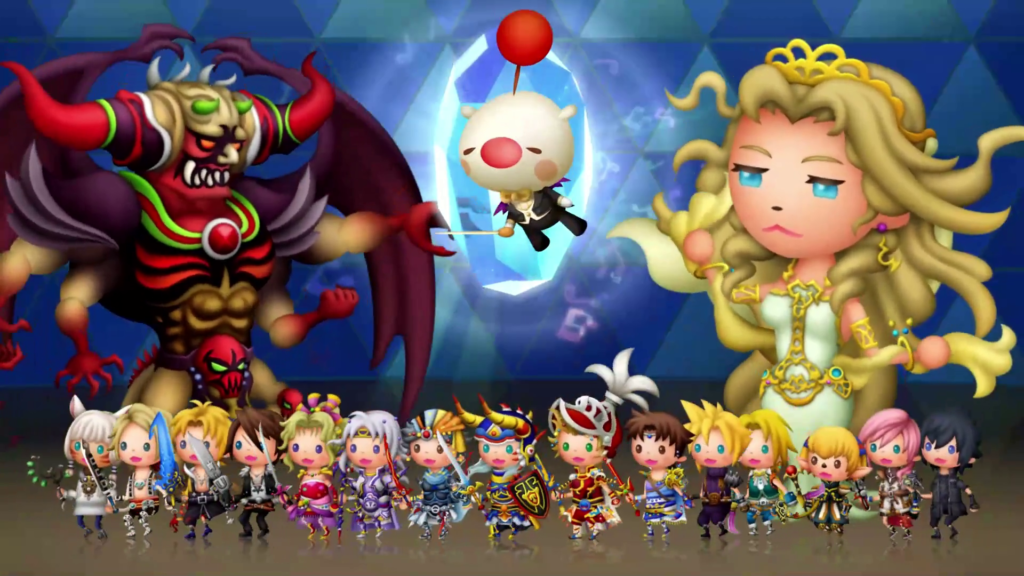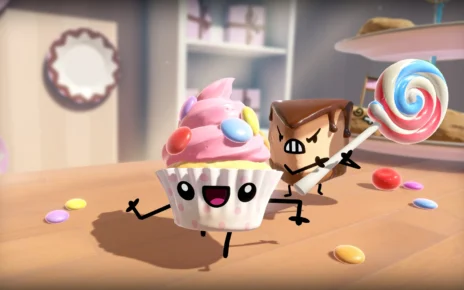We’re living and playing through an era when we can take Final Fantasy crossover games for granted, especially in the mobile space. The original Theatrhythm Final Fantasy for the Nintendo 3DS, however, dropped at a time when they were still fairly rare. The title paired the unforgettable soundtracks of the first ten Final Fantasy games with character interpretations that resembled paper dolls, a heap of items and abilities to collect, and touch-driven rhythm mechanics that were as addicting as they were precise. The sequel – Theatrhythm Final Fantasy: Curtain Call – added more games (including those outside of Final Fantasy canon), more characters, and a large library of DLC to expand the library further.
For someone who loves the Final Fantasy scores as much as the games themselves, it was manna from heaven. There was a complicated customization metagame that rewarded players for pairing complimentary challenges, characters, and abilities, but it didn’t get in the way of the core gameplay experience: an accessible rhythm game that was overflowing with nostalgic references. Players would drag, swipe, and tap their way through a classic Final Fantasy track in the name of covering ground, dealing damage to a monster, or just reliving a classic cutscene. Repeat hundreds of times for your nostalgia font of choice. It’s no wonder that Square-Enix turned the game into a franchise unto itself, releasing a Dragon Quest spinoff, mobile ports, and even an arcade cabinet to nickel-and-dime thirsty fans even more.
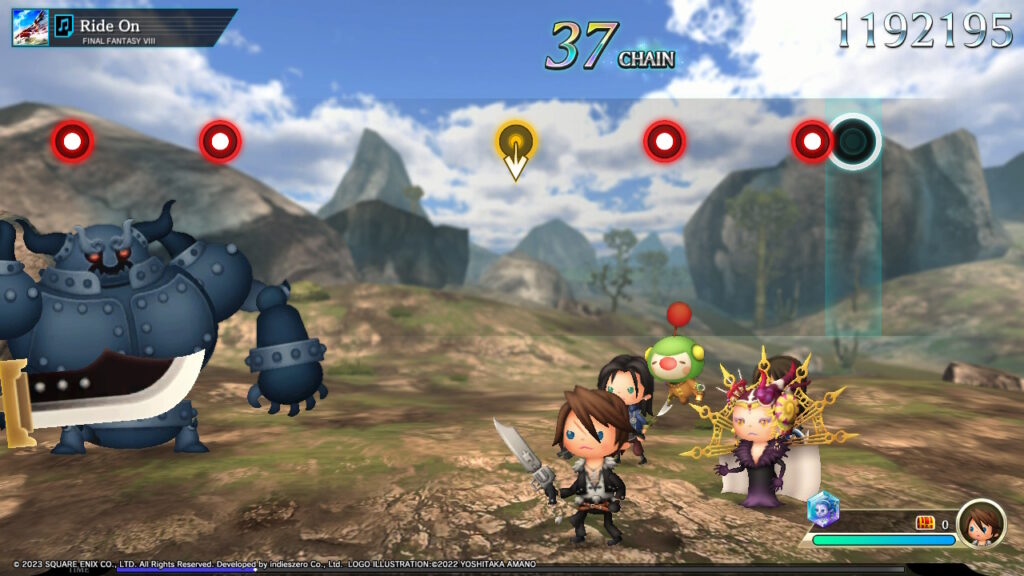
Theatrhythm: Final Bar Line marks the first proper console release of the series in quite a while. It drops the “Final Fantasy” in its title but still features the franchise most prominently against other Square-Enix fare like Chocobo’s Dungeon, Live-A-Live, and an upcoming arsenal of other Square-Enix RPG classics. Even ignoring those expansions, the core Final Fantasy library is massive, including not only the full library of scores from the previous Theatrhythm games but new tracks for those titles, new series that have seen release since the last 3DS title, and even elevations of some Final Fantasy deep cuts. Final Fantasy Mystic Quest, Final Fantasy Crystal Chronicles, Dissidia Final Fantasy, and even the defunct Mobius Final Fantasy have top-level franchise availability among the obvious mainstream entries.
Square-Enix leaned hard into the games whose fan following have boiled over throughout the last decade. Final Fantasy VII, expectedly, has three different series tiles to represent the original game, the 2020 remake, and catch-all for its multitude of spin-offs and prequels. The multiplayer juggernaut Final Fantasy XIV and fallen angel Final Fantasy XI have some of the largest libraries in the entire title, stretching throughout each core game and many expansions. At the same time, the entire Final Fantasy XIII trilogy is lumped together into a single node, and Final Fantasy Tactics gets a tiny library of tracks that fails to acknowledge its solid portable sub-releases. This is going to disappoint a chunk of hardcore fans, many of whom will probably be offset by the group of superusers that are thrilled to see so many obscure mobile games represented, especially those that are no longer available.
This is a big nitpick on my part. On some level, every Theatrhythm game is a equal parts reflection and advertisement for games played before and games yet to be explored, respectively. (If anyone doubts this, ask yourself if it’s a coincidence the game dropped a few months before the full Pixel Remaster series is released for the same two platforms.) The presence of Crisis Core and Final Fantasy XII in Curtain Call incentivized me to play through the two titles, which had fallen to the wayside over the years. Final Bar Line’s massive collection does the main thing, but no matter how compelling I may find the Mobius Final Fantasy soundtrack, there hasn’t been a way to explore the online-only game – legitimately or otherwise – since 2020.
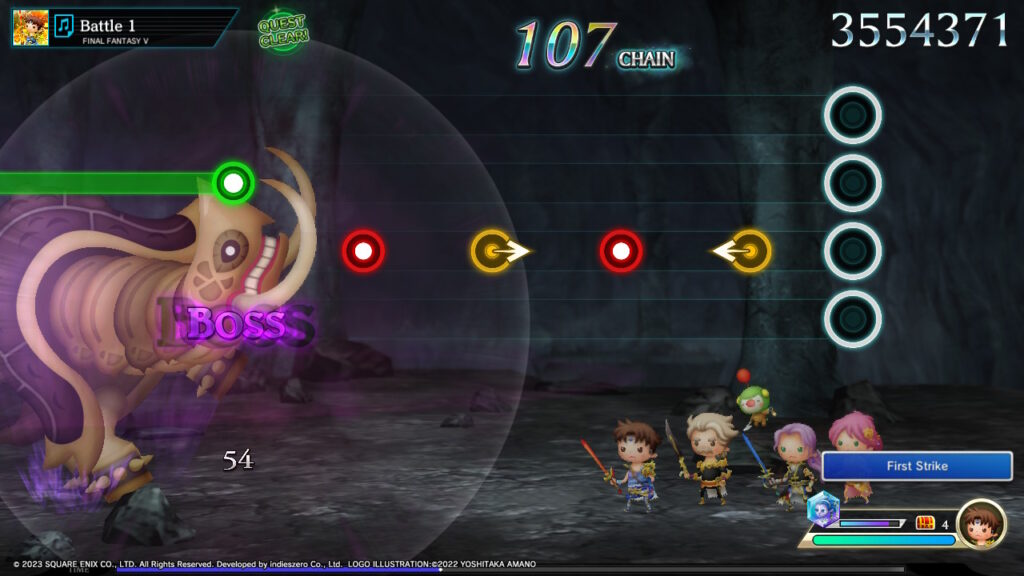
Whether or not other fans share in that frustration, my second big gripe is a little less obtuse. Final Bar Line inherits the art style and character customization subsystems from its predecessors, but despite being released for the touch-enabled Nintendo Switch, the game ditches the old tap/drag/swipe controls in favor of a new button-based system. Final Bar Line players tap buttons and either flick or drag analog sticks to match the highway of triggers this time around. The control sticks, in particular, are terrible substitutes for the 3DS stylus, and the gameplay suffers for it.
Like the original Theatrhythm’s optional button mode, the game doesn’t care which button or stick is used to complete a trigger as long as it’s timed properly, which is fine until the game starts throwing double- and quadruple-triggers at the player. I had a hard time holding my bearings with a couple of these actions. The held notes in BMS stages are particularly egregious as they require the player to roll back and forth between button presses seamlessly, sometimes alongside a tap or a flick. A few bad notes, and it’s easy for the entire track to unravel if you don’t have enough support on your team.
And all this complaining is somewhat pointless. In the end, it’s still a massive bundle of great music loosely wrapped in a passable rhythm game.
For all my complaints about the core gameplay mechanics, Final Bar Line’s progression system is a breath of fresh air compared to the unfocused grinding of its predecessors. Heroes become available by unlocking their respective game series, and villains require the player to clear their series. Final Fantasy VII unlocks Cloud and Sephiroth. Final Fantasy VIII unlocks Squall and Seifer. Final Fantasy Mystic Quest unlocks Benjamin only because nobody remembers the other characters from that game. Clearing songs unlocks basic rewards that can be enhanced by completing certain quests – defeat 10 enemies, take no damage, have Yuna in your party, etc. Clearing a series unleashes all the related unlockables at once, including songs you may have skipped and the rare FMS tracks that are synced to footage from the original game. There are no more gacha mechanics with character unlocks, no awkward character resetting when they reach Level 99, and no spamming “Battle on the Big Bridge” over and over again to get your Rhythmia as high as possible.
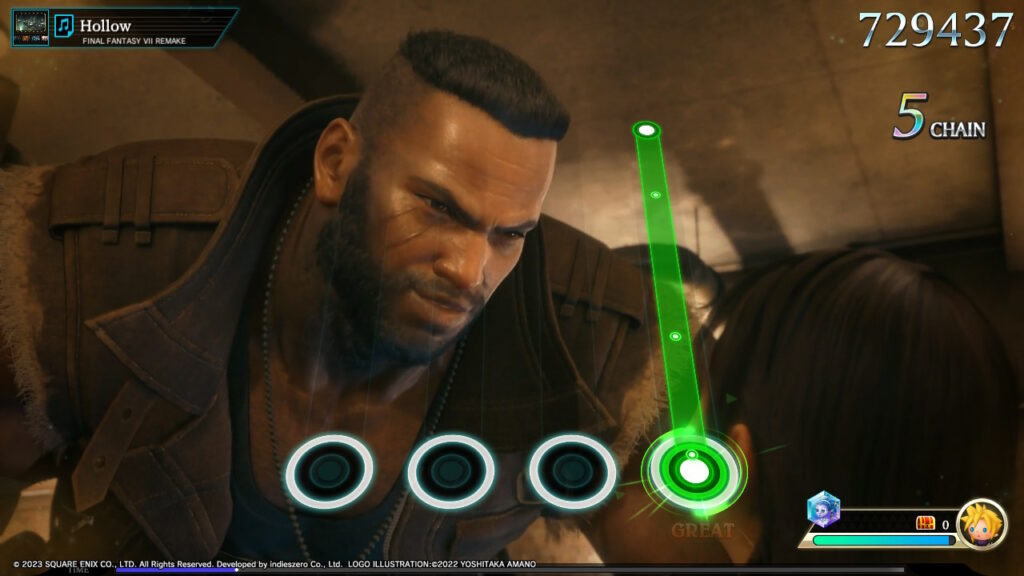
At the start of the Series Quests mode – the name given to the game’s main campaign – you’re given a single key to unlock one of only a few available core series. One of these initial options was Final Fantasy V, however, so the choice for me was easy. You receive an additional Series Key after playing through a few songs from your chosen title, but I figured I’d see the rest of my favorite soundtrack through to its conclusion. There’s a “mode” setting each time you open a track, but to my chagrin, this refers to the song’s difficulty; not an option to switch the instrumentation. As someone who isn’t very interested in the Pixel Remaster games and the shortcuts they’ve taken, it would have been really neat to be able to choose between a game’s original 16-bit version, its mobile version, and its remastered arrangement.
After that, I started to explore the games that past Theatrhythm games had forgotten: Final Fantasy Mystic Quest; Dissidia: Final Fantasy; and even the catch-all “Final Fantasy Series” grouping that includes tracks from Final Fantasy: The 4 Heroes of Light and World of Final Fantasy. I stopped part way through those latter maps when I encountered tracks from Dissidia Opera Omnia and Stranger of Paradise (both of which I haven’t played yet) in favor of some of my all-time favorites like Final Fantasy VIII, Final Fantasy XI, Final Fantasy Tactics, and the incredible rearranged soundtrack of Final Fantasy VII Remake. By that point, the special Theatrhythm series – and the road to the final boss – opened up, the game finishing itself off with some incredible custom medleys that will be captured in an R2Kade video soon.
Square-Enix has scheduled payloads of additional DLC to last us through the end of 2023. Most of the titles cover non-Final Fantasy titles like the Chrono, SaGa, and Mana series, though Final Fantasy XVI is undoubtedly going to be one of the yet-to-be-named titles toward the end of the year. That’s a pretty serious boon to a title that’s already great for quick pick-up-and-play sessions, especially if you’re a fan of the publisher’s expanded library. For fans of Final Fantasy and other classic RPGs, there’s a whole lot to like out of the box and a whole lot more to which to look forward. I just wish the developers had bothered to take advantage of the Switch’s touch features for the portable version of the game.
